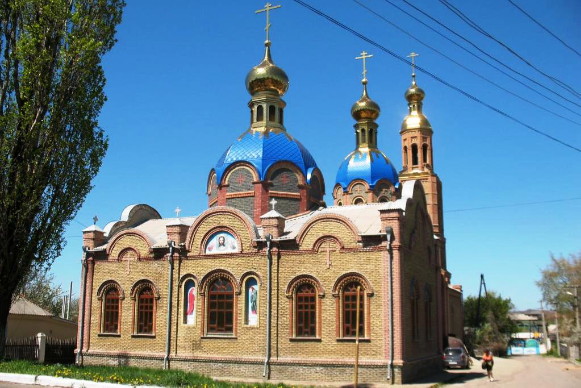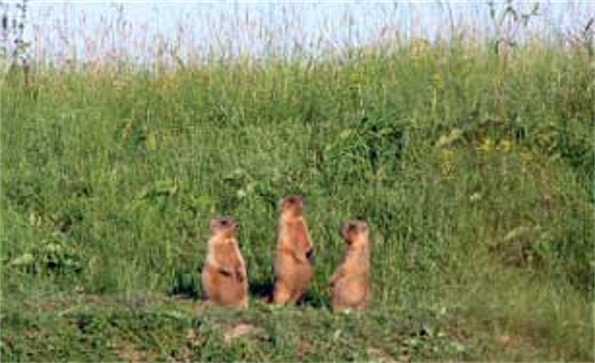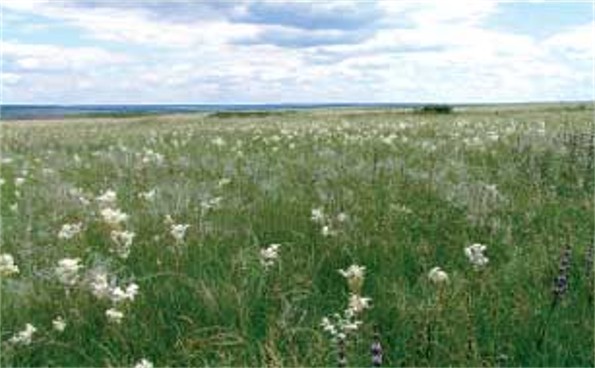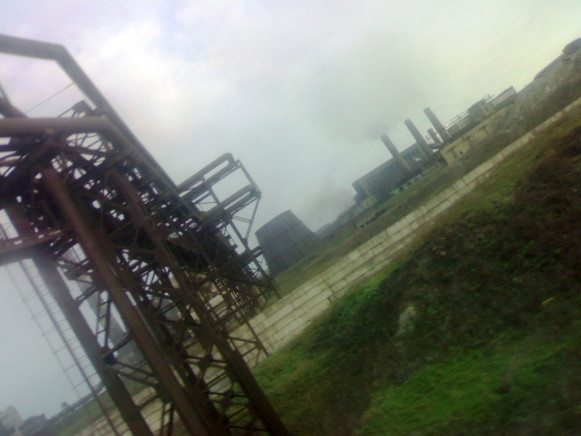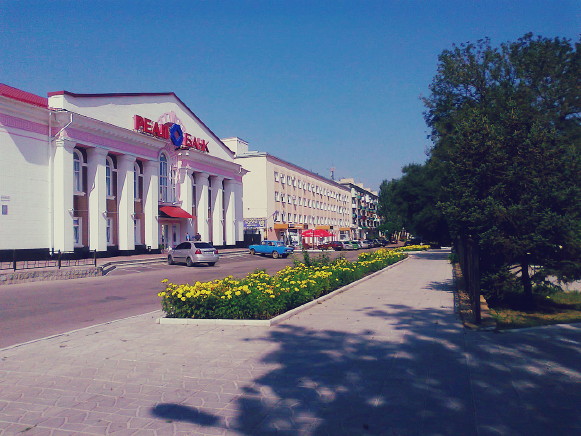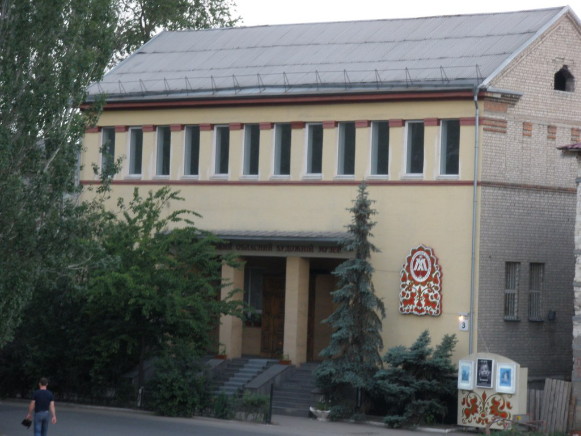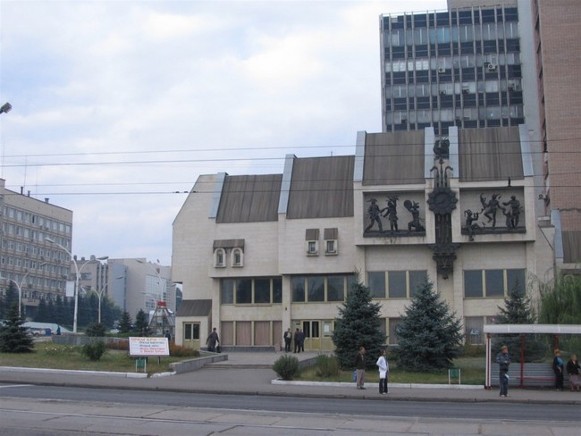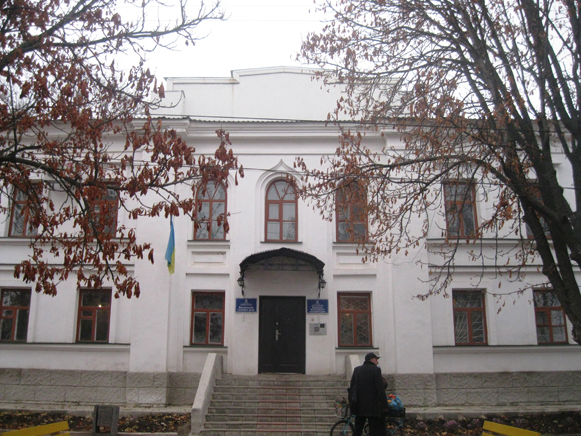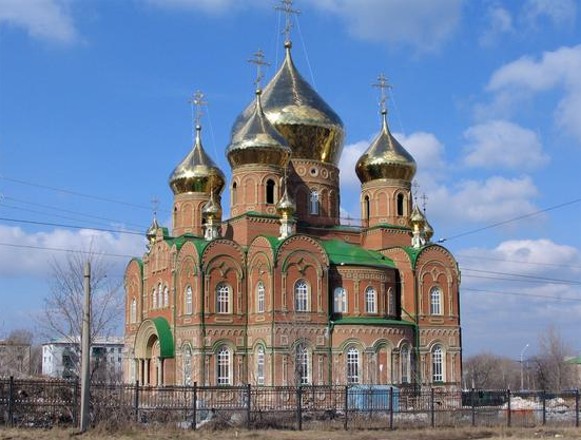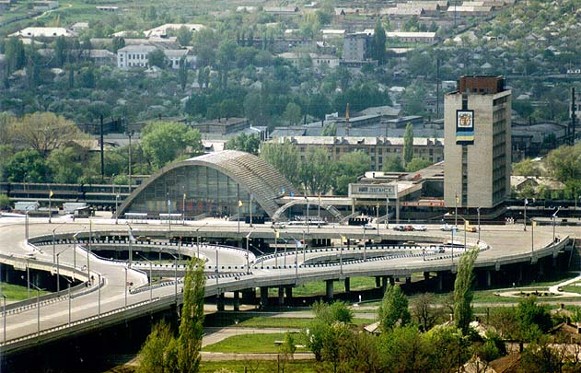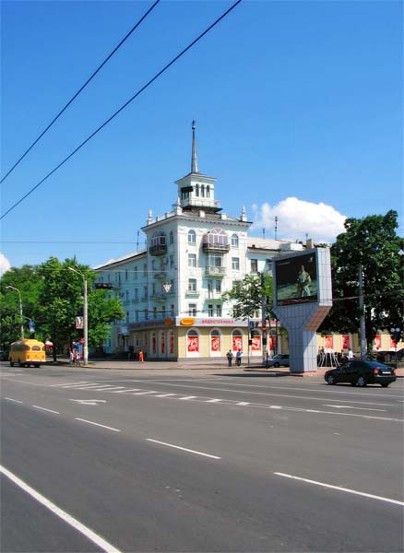Luhansk oblast
Luhansk oblast. An administrative region in eastern Ukraine. Established on 3 June 1938, it was called Voroshylovhrad oblast until 1958, and again from 1970 until 1990. It has an area of 26,700 sq km, an estimated population in 2019 of 2,151,800, of which 1,872,000 or 87 percent were urban. It is divided into 18 raions, 37 cities, 109 towns (smt), and 780 rural settlements. Luhansk (called Voroshylovhrad, 1935–58, 1970–90) was the oblast’s capital until 2014. After the Euromaidan Revolution, the Russia-curated rebellion in the Donets Basin and the establishment with Russian military assistance of the self-proclaimed Luhansk People’s Republic with its capital in Luhansk, the administration of Ukraine-controlled Luhansk oblast relocated to Sievierodonetsk. Following the Minsk II Agreement (12 February 2015), an active front separates the Russia-controlled Luhansk People’s Republic (LPR) from the Ukraine-controlled Luhansk oblast. (Map: Donetsk oblast and DPR; Luhansk oblast and LPR.) The front impedes links in transport, water and power infrastructure.
Physical geography. The Donets River, which flows in a southeasterly direction, divides the oblast into two distinct zones. The northern part consists of a plain rising from the Donets Lowland (50–80 m) northward as hills and river valleys (100–200 m, reaching 222 m) towards the spurs of the Central Upland. The southern region consists of the Donets Ridge, an undulating plain with generally higher elevations (200–250 m, highest point at Mohyla Mechetna, 367 m) dissected by river valleys and ravines. The southern part of the oblast is rich in coal deposits as well as limestone, marl, chalk, and clay. Along the Donets River are deposits of natural gas.
The climate is temperate-continental: the summers are hot (average July temperature: 20.8°C in the north to 21.5°C in the south; absolute maximum 40°C) and dry (300 to 350 mm from April to October), and the winters are cold (average temperature –6.2°C in the south to –7.3°C in the north; absolute minimum –40°C) and offer little snow cover (80 to 90 days, average maximum depth, 20 cm) but more glaze ice accretion (notably on the Donets Ridge, 25 to 30 days, up to 100 mm thick). With annual precipitation ranging from 500 to 550 mm and annual evaporation increasing from 580 mm in the north to 720 mm in the south, the region has moisture deficit, notably in the south, where dry winds (sukhovii) and dust storms in the spring are common (on average, 6 days per year). The growing season, with temperature over 10°C, may last for 165 to 175 days of the year; the frost-free season, from 160 days in the north to 180 days in the south.
The water resources of the oblast are limited. The main tributaries of the Donets River are the Luhan River and the Velyka Kamianka River on the right bank and the Krasna River, the Borova River, the Aidar River, and the Derkul River on the left. Southern slopes of the Donets Ridge are drained by the upper reaches of the Miius River and its left tributary, the Naholna River. Summer downpours, notably in the Donets Ridge, result in quick runoff and high water turbidity.
Chernozems cover 81 percent of the oblast’s surface. In the north they are ordinary chernozems, formed on loess and susceptible to erosion; in the south the chernozems were formed on stony or on carbonate parent materials and are slightly less fertile. Separating the two is a narrow belt of turfy sandy soils on the left-bank alluvial terraces of the Donets River.
Only 11 percent of the oblast is covered by forests. In the ravines the prevalent trees are oak, ash, maple, pear, and apple, and in the floodplains, alder, poplar, and willow. Sandy terraces along the Donets River support pine and oak. Shelterbelts account for 20,500 ha and comprise of drought resistant acacia, oak, maple and ash. Most of the natural steppe vegetation in the oblast has been replaced with cultivated plants; only remnants are left, along riverbanks and in the Luhansk Nature Reserve.
History. The territory of the oblast has been inhabited since the Paleolithic Period. In antiquity, it was part of the domain of the Cimmerians (8th century BC), the Scythians (7th–3rd centuries BC), the Sarmatians (3rd century BC–230 AD), and the Alans (a Sarmatian tribe, 200–550 AD), and transited by the Huns (250–375 AD) and the Avars (550). The Alans were then displaced northward by the Onogurs or Ogurs (a proto-Bulgarian Turkic-speaking people), who lived here from the 6th to 9th centuries AD. The territory was part of the Khazar Kaganate in the 8th century. When the Kyivan Rus’ princes (most notably, Sviatoslav I Ihorovych) ended the Khazar domination and tried to control the area, the Onogurs were displaced by the invading Pechenegs or Pechenihy (9th–11th centuries), then the Polovtsians or Cumans (11th–13th centuries), and the Mongol-Tatars of the Golden Horde (13th–15th centuries). When in the mid 15th century the Crimean Khanate separated from the disintegrating Golden Horde, its successor, the Astrakhan Khanate, came to possess this grassland for its Kipchak nomads. After Muscovy conquered Astrakhan (1556), it claimed this area and proceeded to establish its control there. Wary of Crimean Tatar raids, Muscovy set up forts and palisades in the forests bordering the steppes (the Tula Line, 1560s; the Belgorod Line, 1630s–50s) and sent out patrols into the steppe. It commissioned pioneers of the Donets River basin (Muscovite documents refer to the ‘Cherkasy’ from the Dnipro River basin and the ‘Severiuki,’ formerly known as Siverianians, from the Putyvl and Kursk areas) to build forts and join the border service. A major influx of Zaporozhian Cossacks (1630s, 1650s) reinforced the Belgorod Line by establishing, south of it and under the command of their own regimental officers, settlements forming a territory known as Slobidska Ukraine. Settlements of its southernmost Izium regiment and of its easternmost Ostrohozke regiment (Russian: Ostrogozhsk), based in on the Belgorod Line, expanded south to include the present-day northern third of Luhansk oblast: in the environs of Miluvatka on the Krasna River and of Stara Bila, now Starobilsk on the Aidar River, respectively. To the south, along the Donets River and south of it, the Zaporozhian Cossacks began to settle the territory. They met and competed for salt at Bakhmut (see Bakhmut rock salt deposits) with the Don Cossacks, who came from the east, planting their settlements along the left bank of Donets River. After the capture of the Turkish fortress Oziv (1696), Muscovy extended its claim to the shore of the Sea of Azov and established Azov gubernia which, except for the Slobidska Ukraine, included the rest of present-day Luhansk oblast. Here, runaway serfs from Muscovy found refuge among the Don Cossacks, who protected them by fighting Muscovite retrieval forces. Tsar Peter I put down the Kondratii Bulavin rebellion and had the Don Cossack settlements on the Donets River destroyed (1707).
In the 18th century colonization accelerated as territorial administration was restructured. In 1753, when this area’s northwestern corner was part of Belgorod gubernia, its central northern strip was part of Slobidska Ukraine, and the rest was designated part of Voronezh gubernia, Imperial Russia invited Serbs, Bulgarians, Macedonians, and Wallachians from the Austrian Empire to form a belt of settlements on the lands of the Zaporozhian Cossacks south of the Donets River called Sloviano-Serbia. In 1764 Sloviano-Serbia was combined with other military belts of settlement to form the New Russia gubernia. When the Zaporozhian Sich was liquidated in 1775 and the New Russia gubernia expanded onto its territory, Sloviano-Serbia was included along with the rest of the southern part of the territory as the Bakhmut county of Azov gubernia (1775–82). With the liquidation of the Slobidska Ukraine gubernia (1779), the northern part was included in the Voronezh vicegerency (1779), the southern part in the Katerynoslav vicegerency (1783–1802), and a small eastern wedge and narrow southern strip in the Oblast of the Don Cossack Host. The restructuring back to gubernias (1796) placed the northern part in Slobidska Ukraine gubernia, the southern part in the Katerynoslav gubernia (called New Russia gubernia in 1797–1802), the eastern wedge and southern strip remaining with the Oblast of the Don Cossack Host. The northern part of present-day Luhansk oblast, being in the easternmost counties of the Slobidska Ukraine gubernia, was transferred (1802) to Voronezh gubernia and then (1835) to Kharkiv gubernia.
In-migration and rural population in the region continued to grow. In the last third of the 19th century the southern part, being part of the Donets Basin, experienced rapid industrialization and urbanization, accompanied by a large influx of Russian workers and administrators. This development continued throughout the 20th century.
During Ukraine’s struggle for independence (1917–20) most of the territory (then within Kharkiv gubernia and Katerynoslav gubernia) was claimed as part of Ukraine but was reneged by Russia, occupied by German-Austrian forces, and after their withdrawal contested among the Ukrainian government and the Bolshevik forces, and Anti-Bolshevik Russian Volunteer Army. The Bolsheviks, unable to sustain their Soviet Ukrainian People’s Republic headed by the Kharkiv-based People's Secretariat (December 1917–March 1918), re-established the Ukrainian Socialist Soviet Republic (January 1919, renewed January 1920) and within it the Donetsk gubernia (5 February 1919), expanding it after 16 April 1920 to include not only all of present-day Donetsk oblast but also Luhansk oblast and part of Rostov oblast of today’s Russian Federation. After some border re-adjustments (1920, 1925), the Ukrainian Soviet Socialist Republic was re-structured into okruhas (1923–6), of which the Artemivsk (Bakhmut), Stalino (Donetsk), and Mariupol okruhas corresponded to the present-day Donetsk oblast, while Starobilsk and Luhansk okruhas, to the present-day Luhansk oblast (1925). All five okruhas were merged in 1932 into the larger Donetsk oblast. In 1938 it was split into Stalin oblast (present-day Donetsk oblast) and Voroshylovhrad oblast (present-day Luhansk oblast).
Population. At the start of 2014, Luhansk oblast had 2,234,900 residents, or about 5 percent of Ukraine’s population. Its average population density then was 84 people per sq km, above the 75 persons per sq km for Ukraine as a whole. In the southern part, a conurbation of mining towns and industrial cities of the Donets Basin, the density increased to 300 and over, while in the north it fell to 30 or less. The percentage of urban population, the second highest in Ukraine, increased most rapidly in the 1930s and 1950s: it was 23.7 percent in 1926, 67.4 percent in 1940, 65.3 percent in 1950, 80.4 percent in 1960, 82.6 percent in 1970, 85.2 percent in 1981, 86.5 percent in 1990, 86.4 percent in 2000, 86.7 percent in 2010, and 87.0 percent in 2019. The population suffered two calamities from which it recovered, partly with in-migrants from central Russia: from the Famine-Genocide of 1932–3, to 1,938,500 in 1940, and from the Second World War, to 1,705,100 in 1950. It continued to grow to 2,512,500 in 1960, 2,750,600 in 1970, 2,797,400 in 1980, and 2,866,900 in 1990, peaked at 2,886,000 in 1993 and then declined to 2,628,600 in 2000, 2,311,617 in 2010 and 2,151,800 in 2019. Contributing to population growth was high immigration and average but declining natural increase (17.4 per 1000 in 1960, 8.7 per 1000 in 1965, 6.7 per 1000 in 1970 and 4.8 per 1000 in 1975). Deaths began to exceed births in 1980 among the aging rural population (–1.3 per 1000), from where youth migrated to cities, and then in 1991 among both urban (–1.2 per 1000) and rural (–5.5 per 1000) population. The onset of population decrease, however, was delayed until 1993 by net in-migration (20,300 in 1992), which turned into growing net out-migration (–2,600 in 1993, –18,700 in 1994). Since 1993, net out-migration from Luhansk oblast competed in magnitude with Donetsk oblast for the highest net out-migration from any of the oblasts of Ukraine. In 2014 and after net out-migration from Luhansk oblast was augmented by refugees from the Russo-Ukrainian Donbas war.
Luhansk oblast has a slight majority of Ukrainians in its population and, after Crimea, the second highest proportion of Russians among the regions of Ukraine. Changes in the ethnic composition of the oblast’s population attest to the Russification, partialy reversed with Ukraine’s independence after 1991. The 2001 percentage figures for the largest groups (with 1926, 1959 and 1989 in parentheses) were: Ukrainian, 58.0 (68.1 57.8, 51.1); Russian, 39.0 (28.4, 38.7, 44.8); Belarusian, 0.8 (0.3, 1.1, 1.2); Jewish, 0.1 (1.0, 0.6, 0.3); German, 0.1 (0.8, 0.1, 0.1); and Tatar, 0.3 (0.5, 0.5, 0.4).
As a result of industrialization, factory towns and clusters of mines formed in the Donets Basin, growing into cities and town clusters. The large (over 50,000) cities are all located along the Donets River or south of it. Most are under the LPR control. Grouped by location and population size in 2019 (2001 in brackets) they are: 1) Luhansk (formerly Voroshylovgrad, 1935–58, 1970–90), 404,000 (463,000), with its adjacent city and town, 427,000 (503,000) ; 2) on the west side, along Donets River, the only three large cities under Ukrainian government control: a) Sievierodonetsk, 103,500 (120,000), with its adjacent 4 towns, 112,500 (130,000); b) Lysychansk, 97,300 (115,000), with its adjacent two small cities, 111,000 (121,000); and c) Rubizhne, 57,000 (65,000); 3) a large conurbation 30 km south of Lysychansk and 50 km west of Luhansk, including: a) Alchevsk (Yurivka until 1901, Alchevsk, 1901–31, Voroshylovsk, 1931–61, Komunarsk, 1961–92), 107,400 (119,000); b) Kadiivka (Serho, 1937–43, Kadiivka, 1943-1978, Stakhanov, 1978–; the Ukrainian government, in its 2016 de-Sovietization legislation, renamed it back to Kadiivka, but LPR does not recognize the change), 75,000 (90,000), with adjacent 2 cities, 88,200 (108,000); c) Brianka, 45,400 (55,000), with adjoining 5 towns, 51,400 (61,000); d) Pervomaisk (Luhansk oblast), 37,000 (49,000), with adjoining towns, 67,000 (81,000); e) Holubivka (Kirovsk since 1932; in 2016 the Ukrainian government re-named it back to Holubivka, but LPR does not recognize the change), 27,000 (39,000), with adjacent 2 towns, 32,000 (45,000); 4) a conurbation 40 km south of Alchevsk, forming a belt from Donetsk oblast in the west to the border with the Russian Federation in the east: a) Krasnyi Luch (originally Kryndachivka until 1920, when it was re-named Krasnyi Luch; re-named Khrustalnyi in 2016 by the Ukrainian government), 80,300 (95,000), with adjacent 3 cities and 8 towns, 119,100 (145,000); b) Antratsyt, 52,700 (64,000), with 6 towns, 74,000 (91,000); c) Rovenky, 45,900 (54,000), with 10 adjacent towns, 78,500 (92,000); d) Sverdlovsk (re-named Dovzhansk by the Ukrainian government in 2016), 63,400 (73,000), with a city and 6 towns, 94,000 (110,000); 5) a small urban belt 40 km southeast of Luhansk near the border with the Russian Federation, comprises Krasnodon (originally Sorokynskyi Rudnyk until 1938, when it was re-named Krasnodon; re-named Sorokyne by the Ukrainian government in 2016), 43,000 (51,000), with 2 adjacent cities and 8 towns, 100,000 (118,000).
Since 2015, the Russia-controlled Luhansk People’s Republic (LPR) holds about 8,691 sq km or 32.6 percent of the oblast’s territory. It extends from the border of the Russian Federation to include the conurbations south of the Donets River westward to include Pervomaisk (Luhansk oblast). Territory north of the Donets River and north and west of Pervomaisk is in the Ukraine-controlled Luhansk oblast. Of the 2,151,800 estimated population of Luhansk oblast in 2019, 1,485,300 or 69.0 percent resided in the LPR.
Luhansk has some of the largest and oldest post-secondary institutions in the Donets Basin established by the Soviets in the 1920s. In the post-Soviet period the emphasis in education shifted from technical training to academic education. Of the professional-technical postsecondary schools and colleges in Luhansk oblast, there were 40 with 43,300 registered students in 1988–9 school year, and 43 with 33,400 students in the 1995–6 school year, declining by 2010–11 to 28 with 17,300 students. Of the academies, institutes and universities, there were 5 with 33,100 students in 1988–9, and 7 with 30,000 students in 1995–6, growing to 10 with 88,100 students in 2010–11. The outbreak of the Russo-Ukrainian Donbas war in 2014 disrupted education and forced some members of the institutions to relocate to the Ukraine-controlled area. Thus the Eastern Ukrainian National University (formerly, the Luhansk Machine-Building Institute, the largest in the former USSR, founded in 1920, upgraded to national university in 2001, with established campuses in several cities), is now split between two head offices: one in the LPR-controlled Luhansk and one in the Ukraine-controlled Sievierodonetsk. A larger share of faculty and students of the Luhansk National University (established in 1921 as a State Pedagogical Institute, upgraded to university in 1998 and to national university in 2003, established satellite campuses in Starobilsk in 1988, Rovenky in 1989, and Stakhanov in 2005) was relocated from Luhansk to Starobilsk, opening new satellite campuses at Kreminna, Lysychansk, and Poltava. Many faculty and students of the Luhansk National Agricultural University (formerly Luhansk Agricultural Institute, est. 1921) found refuge in 2014 at the Kharkiv National Agrarian University, establishing by 2020 separate campuses at Starobilsk, Sloviansk, and Illinivka (near Kostiantynivka in Donetsk oblast). Similarly, many faculty and students of the Luhansk State Medical University moved to Ukraine-controlled Rubizhne. Alchevsk hosts the Donbas State Technical University (formerly the Voroshylovsk Mining-Metallurgical Institute, est. 1957) with branch campuses in Stakhanov (now Kadiivka), Krasnyi Luch (now Khrustalnyi), Krasnodon (now Sorokyne), Lysychansk, Pervomaisk, Rovenky, Sverdlovsk (now Dovzhansk), and Yenakiieve (in Donetsk oblast); since 2014, its Ukrainian head office was moved to the only campus under Ukrainian control at Lysychansk. In Rubizhne, the former Dnipropetrovsk Chemical-Technological Institute became part of the Eastern Ukrainian National University.
Economy. Based on rich mineral resources, a developed transportation network and strong agricultural sector, Luhansk oblast is Ukraine’s major industrial region. As a share of Ukraine’s total, Luhansk oblast occupied 4.4 percent of its territory and in 2010 had 5.0 percent of its population. Its gross regional product (before Russia’s annexation of the Crimea) gradually declined from 5.0 percent in 1996 to 4.2 percent in 2006 and 3.6 percent in 2013. While its share of fixed assets in 2009 in all enterprises of Ukraine was 2.9 percent and in agriculture it was 2.6 percent, in industry it was 4.8 percent. In 1999, the economic profile of Luhansk oblast (and in comparison to Ukraine as a whole) as percent of its gross regional product (and gross national product, respectively), was: industry, 48.3 (35.8); transport and communications, 12.5 (14.8); agriculture, 11.2 (14.1); services, 11.1 (14.7); trade, 5.6 (9.9); housing, 6.7 (5.5); and construction, 4.6 (5.2).
After the severance of the Russia-controlled LPR, the gross regional product of the remaining Luhansk oblast controlled by Ukraine contributed in 2018 only 1.0 percent to Ukraine’s gross national product. The economic profile of Luhansk oblast under Ukraine’s control in 2018 also changed: industry declined to 23 percent; agriculture grew to 21 percent; financial services, 8 percent; trade, 7 percent; and transport and communications, down to 4 percent.
This change reflects the fact that Luhansk oblast is made up of two economic-geographical regions: northern and southern. The northern region (north of the Donets River), is wholly controlled by the government of Ukraine. It is predominantly rural, its agriculture comprising grain and oil-yielding crops, dairy and meat animal husbandry. The southern region is part of the Donets Basin. It is highly industrialized (mining and heavy industry) and has suburban agriculture. Except for its northwestern corner, it is held by the Russia-controlled LPR.
Industry. Luhansk oblast contains part of the Donets Basin, the main mining and metallurgical complex of Ukraine. On the basis of its coal resources, it developed metallurgy, machine-building, chemical, construction, and food processing branches. Industry peaked in the 1980s, stagnated in 1990 and was privatized after 1991. Despite the loss of state investments, its contribution in output and percent of Ukraine’s production in 2013 (the previous years, 1990 and 2000, in brackets) remained significant: coal, 18.2 million tons or 28.2 percent (51.6 million tons, 33.2 percent; 21.6 million tons, 27.0 percent); steel, 0.83 million tons, 5.5 percent (3.87 million tons, 7.4 percent; 2.90 million tons, 9.2 percent); steel tubes, 105,000 tons or 5.8 percent (278,600 tons, 4.3 percent; 61,100 tons, 3.5 percent); lime, 491,000 tons or 12.6 percent (451,900 tons, 6.8 percent; 59,900 tons, 2.0 percent).
The industrial profile of Luhansk oblast in 2000 by leading branches, as percent of the total value of its industrial production, was: energy supply, 36.6 percent; metallurgy, 32.8 percent; chemical and petrochemical, 9.7 percent; machine-building and metal fabrication, 7 percent; food processing, 6 percent; other, 7.9 percent. After 2014, with the loss of the main coal mining and metallurgical complex to the Russia-controlled LPR and the disruption of supply chains, industrial production of Luhansk oblast declined. The industrial profile of Luhansk oblast controlled by Ukraine in 2018 also changed as follows: energy supply, 28.9 percent; wood, paper products and printing, 19.4 percent; chemical products, 13.6 percent; mining, 7.3 percent; metallurgy and metal fabrication, 2.6 percent; other, 28.2 percent.
Near its peak in 1986, the main industries of Luhansk oblast were the fuel industry (27.3 percent of the industrial output), including the coal industry (19.2 percent), machine building and the metalworking industry (24 percent), the chemical industry (14 percent), and ferrous metallurgy (12 percent). The energy for those industries was supplied by thermoelectric power plants: at Shchastia (on the north bank of the Donets River, 17 km north of Luhansk, now within the front line of the Ukrainian armed forces), Sievierodonetsk, and Lysychansk (both under Ukrainian government control). Coal mining in Luhansk oblast, producing 64.1 million tons in 1960 (37.2 percent of Ukraine’s total) was conducted by 9 consortia, which controlled 94 mines and 28 enrichment plants. Rising mining costs discouraged the privatization of the less profitable mines in the 1990s, so their gradual declining output (19.9 million tons in 2011, 18.2 million tons in 2013) was subsidized by the state. The Russo-Ukrainian Donbas war and lack of subsidy since 2014 sharply disrupted production. On the Ukraine controlled side, comprising bituminous coal used in coke production, output dropped (in millions of tons) from 10.9 in 2014 to 5.3 in 2016 and 0.3 in 2018. On the Russian-controlled LPR side, the shipment of clean-burning anthracite to Ukraine controlled plants as clean fuel, having been stopped in 2017, was redirected to illicit export as Russian coal. Lacking coal, in 2018 the power stations switched to the more expensive but cleaner natural gas. The metallurgical industry used local coking coal but depended on enriched iron ore from the Kryvyi Rih Iron-ore Basin for the manufacture of steel at the Alchevsk Metallurgical Complex (then called Komunarsk Metallurgical Plant), ferrous alloys (Kadiivka, formerly Stakhanov), and steel tubing (Luhansk). The machine building and metalworking industries produced transportation vehicles. A full range of locomotives were designed and built at the Luhansk Locomotive Works, (the largest in Eastern Europe; founded in 1896 by the German industrialist, Gustav Hartmann, to supply steam locomotives for the Russian Empire; developed and modernized in Soviet period; state-owned by Ukraine; after 2014 its corporate office was moved to Moscow); motor-vehicle repair and assembly plant at Luhansk (went bankrupt in 2001); railway freight cars of all types were designed and built at Kadiivka (formerly Stakhanov); mining machinery at Khrustalnyi (formerly, Krasnyi Luch); electromechanical equipment at Pervomaisk (Luhansk oblast), and computers at Sievierodonetsk. The chemical industry includes a petroleum refinery in Lysychansk (capacity, 7 million tons a year, second largest in Ukraine, declared unprofitable and shut in March, 2012 by the Russian oil firm TNK-BP), a nitrogen fertilizers plant in Sievierodonetsk (one of the largest in Ukraine, privatized and expanded by the fertilizer monopolist, Dmytro Firtash), an aniline dyes factory in Rubizhne (Rubizhne Krasytel Manufacturing Consortium, est. 1916), a soda plant in Lysychansk (producer of soda ash and baking soda, the second largest in Ukraine), and paper and corrugated cardboard plants at Rubizhne (one of the largest in Ukraine) and a smaller one in Luhansk. The large building materials industry produces about half of the window glass in Ukraine (Lysychansk) as well as brick, silicate blocks, ceramic plates, and reinforced-concrete products. The main products of light industry include clothing, (in most cities, the largest enterprises in Luhansk), textiles (Luhansk, Sievierodonetsk), knitwear (Rubizhne), and footwear (Luhansk, Pervomaisk, and Rovenky). Food processing is more widely dispersed: meat processing is concentrated in or near large cities in the south (Luhansk, Krasnodon, Sverdlovsk, Perevalsk, and Lysychansk); milk processing is more widespread, with fluid milk and ice cream more concentrated in big cities; sunflower oil extraction and refining is concentrated in the north, where most sunflowers are grown, while grain milling (5.9 percent of Ukraine’s total flour production in 2013) has larger enterprises near large cities (Luhansk, Alchevsk, Sievierodonetsk). There are distilleries (Luhansk, Starobilsk) and breweries (Luhansk, Lysychansk, Kreminna, Rovenky) of regional significance.
Agriculture. The agricultural production of Luhansk oblast as a share of Ukraine’s output declined from 3.3 percent in 1990 to 2.9 percent in 1995, 2.7 percent in 2000, and 2.6 percent in 2013. The portion controlled by Ukraine in 2018 contributed 1.8 percent. The contribution of animal husbandry also declined as crop production increased. Crop production as percent of the total agricultural production of Luhansk oblast increased (catching up to Ukraine’s percentages, in brackets) from 39.6 (45.6) in 1990 to 52.0 (55.9) in 2000 and 62.1 (63.9) in 2010. By 2018, the share of crop production in the total agricultural production of the portion of Luhansk oblast controlled by Ukraine surpassed the mean for Ukraine with 86.1 (73.7) percent.
Farming enterprises also changed. In 1986, Luhansk oblast had 169 collective farms, 152 state farms and 8 poultry factories. By 1991 family farm enterprises were beginning to emerge. As the free market economy undermined viability of collective farms, privatization accelerated on the basis of rented land. By 1995 the huge socialized farms disaggregated into smaller, more numerous 209 collective farms and 254 state farms, or re-organized into 8 agricultural cooperatives, 1 corporate farm, or spun off 1,247 family farms. By 2013 Luhansk oblast had 1,299 family farms, while the remaining collective and all but 4 state farms converted into 233 corporate farms, 153 private farm enterprises, 12 farm cooperatives, and 39 other forms of farm entities. Rural households, however, continued to practice subsistence gardening and subsidiary animal husbandry on their personal plots.
Over the years, Luhansk oblast lost farmland to mining and other uses. Of the total land area (2,668,300 ha) of Luhansk oblast, farmland occupied 1,898,200 ha (71.1 percent) in 1971, declining to 1,880,900 ha (70.5 percent) in 1990, 1,810,600 ha (67.9 percent) in 2000 and 1,741,600 ha (65.3 percent) in 2007.
The use of farmland also changed. In 1971, of the total farmland (1,898,200 ha), tilled land occupied 1,459,300 ha (76.9 percent of the farmland), hayfields, 36,000 ha (1.9 percent), pastures, 367,800 ha (19.4 percent), orchards and berry patches, 57,400 ha (3.0 percent), of which 43,900 ha (2.3 percent) were of fruit-bearing age, and vineyards, 200 ha (0.01 percent), of which about 100 ha were of fruit-bearing age. Under irrigation were 53,700 ha, including 51,600 ha of field crops and 2,000 ha of orchards, berry plantings and vineyards. By 1988, of the total farmland (1,888,000 ha), tilled land declined to 1,457,000 ha (77.2 percent) and hayfields to 30,000 ha (1.6 percent), but pastures grew to 375,000 ha (19.9 percent). Farmland and its tilled share continued to decline: by 2007 to 1,741,600 ha, of which 1,225,000 ha (70.3 percent) was tilled, and by 2010 to 1,910,200 ha, of which 1,274,300 ha (66.7 percent) was tilled. Even greater decline occurred in the labor-demanding orchards and berry patches of fruit-bearing age: 1990, 20,300 ha (1.1 percent of farmland); 2000, 10,500 ha (0.6 percent); 2007, 7,600 ha (0.4 percent). Areas sown to field crops also declined: from a peak in 1971, 1,451,300 ha (76.5 percent of farmland) through 1987, 1,352,000 ha (71.6 percent), 1994, 1,249,000 ha (67.1 percent), and 2007, 963,700 ha (55.3 percent).
Field crops in 1971 comprised the following (percent in brackets): all grains, 632,900 ha (43.6), of which 228,700 ha (15.8) was winter wheat, 129,800 ha (8.9) spring barley, 15,000 ha (1.0) buckwheat, 136,500 ha (9.4) corn for grain, and 18,600 ha (1.3) leguminous grains; the main industrial crop was sunflower, 153,900 ha (10.6); staple crops were potatoes, 37,600 ha (2.6) and vegetables, 23,800 ha (1.6); of the feed crops, 594,800 ha (41.0), the principal ones were corn for silage and fodder, 343,600 (23.7), followed by perennial grasses, 76,100 ha (5.2).
The composition of the main crops changed over time. Grain and especially technical crops (after 2000) increased with opportunity for export. Their areas in hectares (and percentage of total sown area in brackets) changed as follows: grain crops, 1971, 632,900 ha (43.6), 1987, 689,000 ha (51.0), 1994, 568,000 ha (45.5), 2007, 531,500 ha (55.2), and 2013, 555,000 ha (53.9); technical crops, 1971, 153,900 ha (10.6), 1987, 141,000 ha (10.4), 1994, 135,000 ha (10.8), 2007, 303,600 ha (31.5), and 2013, 376,000 ha (36.5). The staples, potatoes and vegetables, grown largely on personal plots, rose and declined in keeping with the oblast’s population: 1971, 61,400 ha (4.2), 1987, 65,000 ha (4.8), 1994, 69,000 ha (5.5), 2007, 58,500 ha (6.1), and 2013, 50,000 ha (4.9). Feed crops declined steeply with the sharp reduction of livestock on commercial farms after 1994: 1971, 594,800 ha (41.0), 1987, 457,000 ha (33.8), 1994, 477,000 ha (38.2), 2007, 70,100 ha (7.3), and 2013, 49,000 (4.8).
Because of its climate, grain yields in Luhansk oblast are more variable and lower than average for Ukraine. The average yields in 1970–5, in centners per ha, were: all grains, 19.8; winter wheat, 22.7; potatoes, 43.8; sunflowers, 14.6; all were lower than averages for Ukraine. After 2007, crop yields increased but remained below averages for Ukraine. The two 5-year averages (2005-09, 2014-18), in centners per ha (with Ukraine averages for comparison in brackets) were: grain, 22.3, 30.6 (27.3, 44.2); potatoes, 136.9, 161.8 (134.2, 168.4); and sunflowers, 12.9, 17.8 (13.8, 21.3).
Animal husbandry accounted for 60.4 percent of the oblast’s agricultural output in 1990. This included, in 1990, the contribution of: beef and dairy cattle-raising with 852,600 head of cattle (3.5 percent of all cattle in Ukraine), of which 297,800 (3.6 percent) were cows; hogs, 653,000 (3.4 percent); sheep and goats, 237,400 (2.8 percent); and poultry, 10.4 million (4.2 percent). Bee-keeping was and remains an important subsidiary activity. Horses were also kept. With the end of Soviet state subsidies and privatization, the livestock sector diminished. Cattle experienced the steepest decline (data for 1995, 2000, 2007, and 2013), 575,900, 239,000, 133,200, and 112,000; cows, a valued domestic milk source, declined less steeply: 234,600, 126,500, 70,900, and 55,000. Hog numbers declined erratically: 359,700, 119,200, 144,300, and 107,000. Sheep and goats, kept in part for subsistence, declined little after the initial commercial selloff: 135,500, 83,500, 57,700, and 59,000. The same occurred with poultry, but with a gradual recovery in commercial operations (in millions): 5.7, 3.4, 5.4, and 5.8. By 2010 the contribution of animal husbandry to the total value of agricultural production of Luhansk oblast had diminished to 37.9 percent and by 2018, in the area controlled by Ukraine, to 13.9 percent.
Transportation. Luhansk oblast has a relatively dense railway network (45 km per 1000 sq km), denser in the south than in the north. In 2013 the oblast as a whole had 1,192 km of track; by 2018 only 544 km of track were left under Ukraine’s control. The three main lines crossing the oblast, double-tracked, are 1) the east to west Stanytsia Luhanska–Luhansk–Debaltseve–Horlivka, from where main lines lead to Donetsk and Mariupol, to Kyiv via Dnipro, to Moscow via Kharkiv and to Rostov-na-Donu via Ilovaisk; 2) the northwest line: Debaltseve–Kadiivka–Pervomaisk (Luhansk oblast)–Lysychansk–Rubizhne–Kupiansk, from where it branches out to Kharkiv and Moscow; and 3) the southern, west to east, electrified coal collector line: Debaltseve–Rovenky–Dovzhansk, with branches along the way to Khrustalnyi and Antratsyt. Single-track lines with distant direct connections from Luhansk include: 1) Stanytsia Luhanska–Starobilsk–Valuiki–Moscow, 2) Stanytsia Luhanska–Millerovo, which is on the main line Moscow–Kamensk-Shakhtinskii, 3) Stanytsia Luhanska–Molodohvardiisk–Dovzhansk–Novoshakhtynsk–Rostov-na-Donu, and 4) Luhansk–Lutuhyne–Krasnodon–Volgograd. The largest railway junctions are Popasna, Rodakove (west of Luhansk), Luhansk, Kindrashivska (at Stanytsia Luhanska), and Simeikyne (at Molodohvardiisk).
In 2013 there were 5,900 km of highway, 5,800, km of which were paved, mostly in the 1970s and 1980s. The two main highways running through the oblast are Kharkiv–Debaltseve–Antratsyt–Rostov-na-Donu (M 19, severed since 2014 northwest of Debaltseve), and the Dnipro–Donetsk–Debaltseve–Luhansk–Volgograd (M 21, severed since 2014 west of Donetsk). The Stavropol–Moscow and Soiuz gas pipelines and the Samara–Sloviansk and Groznyi–Lysychansk oil pipelines cross the oblast. Pipelines used to convey products from the Lysychansk refinery to Luhansk and to Donetsk. There are two main airports: near Luhansk (destroyed in 2014) and Sievierodonetsk (operational, under Ukrainian government control).
Tourism. In Soviet times Luhansk oblast was closed to foreign tourists. Since 1991, it was opened up to international tourism. The oblast had, until 2014, significant cultural attractions, notably in Luhansk: 4 museums (including heritage of Luhansk oblast, oblast conservation of nature, fine arts, and aviation technology), 3 theatres (Russian drama, Ukrainian drama, and puppet theater), philharmonic orchestra, circus, botanical gardens, educational institutions, sports complexes, churches, Soviet-era monuments and war memorials. Regional studies museums are also located in 12 other cities: Alchevsk, Antratsyt, Bilokurakyne, Dovzhansk, Kadiivka, Khrustalnyi, Kreminna, Lysychansk, Pervomaisk (Luhansk oblast), Rovenky, Sorokyne and Starobilsk.
Natural attractions include the Luhansk Nature Reserve (est. 1968, 2,122 ha) comprising three sites, the Stanychno-Luhansk Preserve, the Provalskyi Steppe, and the Striltsivskyi Steppe; the Bilovodsk Regional Landscape Park (est. 2001, 14,011 ha); and two parks of national significance: Hostra Mohyla (est. 1980, 86 ha), and Druzhba (est 1980, 50 ha). The main recreational zone is in the wooded areas along the Donets River, notably near Kreminna (lakes, forests) and along the Aidar River near Starobilsk and Novoaidar (forests, mineral springs). In the Soviet period, hotels in cities accommodated domestic visitors; near cities water reservoirs were built for local outdoor recreation; a network of sanatoria, resorts and youth camps were developed for workers and their children. The network of resorts (68 in 1995, reduced to 26 by 2013), sanatoria (66 in 1995, reduced to 28 by 2013), and facilities for children (880 in 2000, reduced to 788 in 2013) continue to function. Tourism in Luhansk oblast reached a peak in 2007, with 45,008 clients served by tourist agencies, of which 158 were foreign. The largest number of foreign tourists (850) visited Luhansk oblast in 2003. In 2011 there were 112 hotels in the oblast, accommodating 142,399 visitors.
BIBLIOGRAPHY
Istoriia mist i sil URSR: Luhans'ka oblast (Kyiv 1968)
‘Voroshylovhrads'ka oblast'’ in Heohrafichna entsyklopediia Ukraïny, vol 1 (Kyiv 1989)
Natsional'nyi atlas Ukraïny (Kyiv 2007)
Luhans'ka oblast'. Heohrafichnyi atlas (Kyiv 2013)
Chukhlib, T. Donechchyna ta Luhanshchyna – kozats'ki zemli Ukraïny (XVI–XVIII st.) (Kyiv 2014)
Loza, Iu. Istorychnyi atlas Ukraïny (Kyiv 2015)
‘Luhans'ka oblast'’ Statystychnyi atlas rehioniv Ukraïny (Kyiv 2018) http://www.ukrstat.gov.ua/
Ihor Stebelsky
[A new version of this article was written in 2020.]
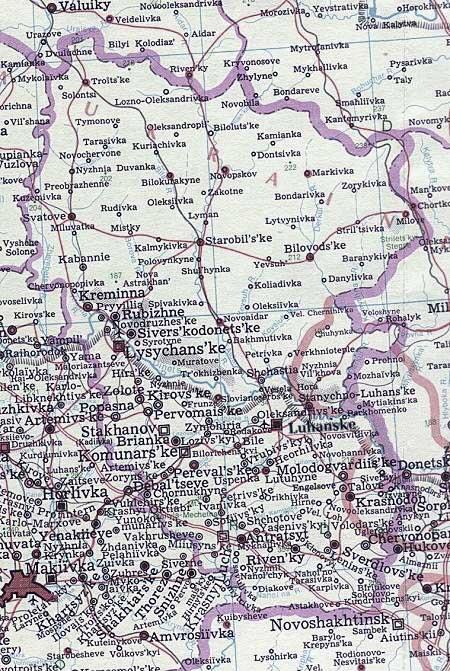
.jpg)
%20mine.jpg)
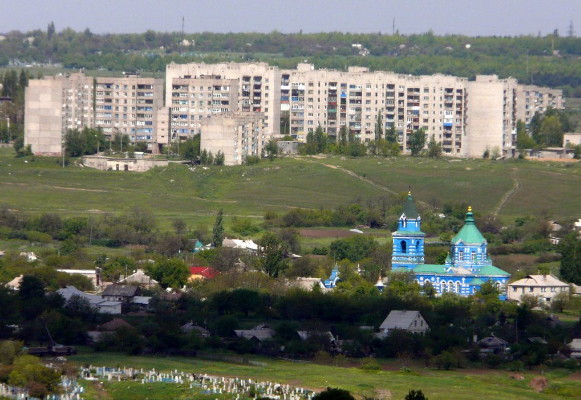
%20railway%20station.jpg)
